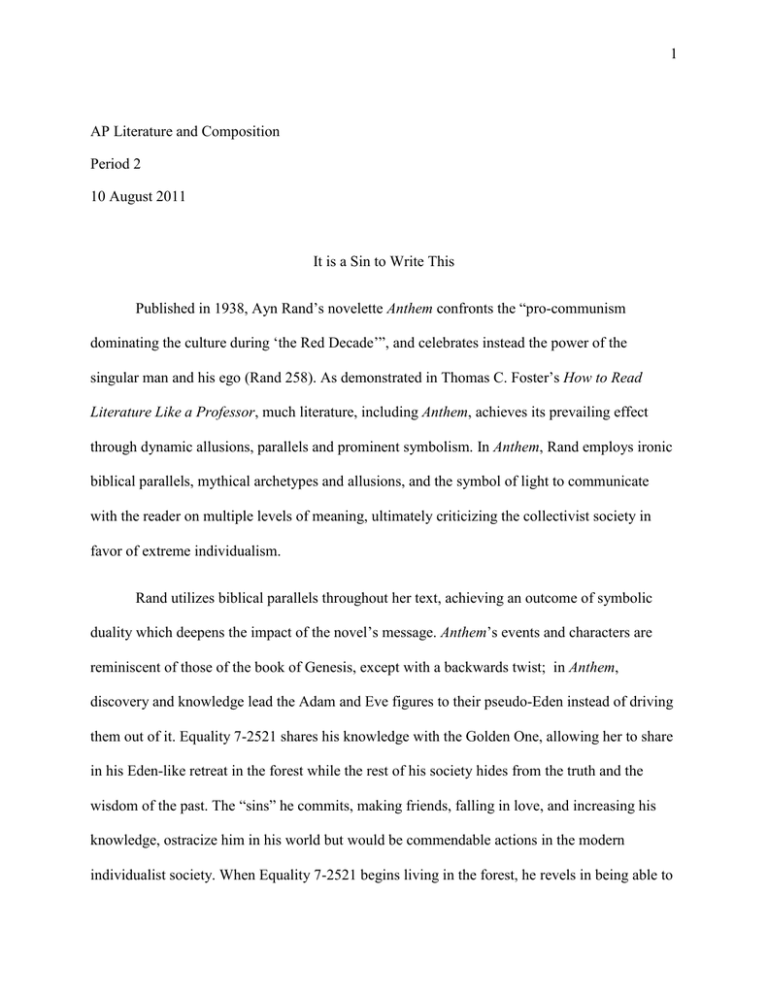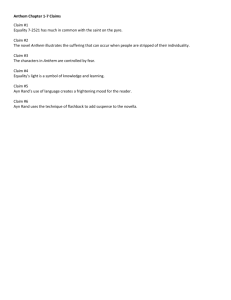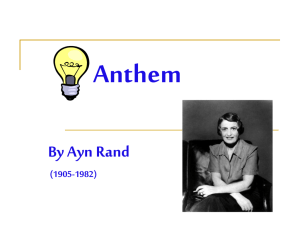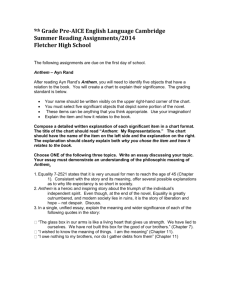Anthem by Ayn Rand: Literary Analysis Essay
advertisement

1 AP Literature and Composition Period 2 10 August 2011 It is a Sin to Write This Published in 1938, Ayn Rand’s novelette Anthem confronts the “pro-communism dominating the culture during ‘the Red Decade’”, and celebrates instead the power of the singular man and his ego (Rand 258). As demonstrated in Thomas C. Foster’s How to Read Literature Like a Professor, much literature, including Anthem, achieves its prevailing effect through dynamic allusions, parallels and prominent symbolism. In Anthem, Rand employs ironic biblical parallels, mythical archetypes and allusions, and the symbol of light to communicate with the reader on multiple levels of meaning, ultimately criticizing the collectivist society in favor of extreme individualism. Rand utilizes biblical parallels throughout her text, achieving an outcome of symbolic duality which deepens the impact of the novel’s message. Anthem’s events and characters are reminiscent of those of the book of Genesis, except with a backwards twist; in Anthem, discovery and knowledge lead the Adam and Eve figures to their pseudo-Eden instead of driving them out of it. Equality 7-2521 shares his knowledge with the Golden One, allowing her to share in his Eden-like retreat in the forest while the rest of his society hides from the truth and the wisdom of the past. The “sins” he commits, making friends, falling in love, and increasing his knowledge, ostracize him in his world but would be commendable actions in the modern individualist society. When Equality 7-2521 begins living in the forest, he revels in being able to 2 work his own land and provide for himself, while in Genesis the toil of the land is considered a curse. Equality 7-2521 also serves as an ironic Christ figure in Anthem. His abuse by the jailers resembles the torture of Christ before the crucifixion, he travels into the wilderness and gains self-insight, and he confronts the so-called “sins” defined by his society but realizes they aren’t sins at all. In addition, when Equality 7-2521 visits with the Golden One at the hedge, she “gather[s] water in their two hands, they [rise] and they [hold] the water out to [Equality 72521’s] lips” in a very sensual gesture evocative of a peasant offering water for Jesus to drink (Rand 57). Also, Equality 7-2521 ultimately plans on redeeming his unworthy society and rebuilding the Unmentionable Times. “Many modern and postmodern texts are essentially ironic, in which the allusions to biblical sources are used not to [support religion] but to illustrate a disparity or disruption” (Foster 52). Religion is a very collectivist institution and paralleling biblical events backwards or ironically calls it into question, tying into Rand’s extreme distaste for collectivism. The tree of knowledge and the pursuit of it are the downfall of mankind in the Bible, but redeem Anthem’s protagonist and allow him to express his individuality. By using mythical archetypes and allusions, Rand allows her characters to operate on multiple layers of meaning accessible to the reader because myth “takes the shape of stories that are deeply ingrained in [humans’] group memory” (Foster 65). Equality 7-2521 functions not only as his own character, but also as the mythical Prometheus, naming himself this at the end of the novel. He also gives the Golden One the name of Gaea, who was “mother of the earth and of all the gods”, who shall become the “mother of a new kind of gods” (Rand 99). According to myth, Prometheus stole fire from the gods and shared it with mankind, and as such, Equality 72521 becomes the bringer of light to the people as he attempts to bring his discovery of electricity to the scholars, even though this fails. By becoming Prometheus, he has earned great 3 power that he alone has. He will choose what friends he will share the light with, and he alone takes on the responsibility of “rebuild[ing] the achievements of the past, and open[ing] the way to carry them further (Rand 99-100). By this, Ayn Rand, through the Prometheus archetype, gives the power to the individual, saying that complete equality hinders progress in society, and that it is the individual who builds empires and promotes progress. “When literal […] darkness and light are introduced into a story, it is nearly always the case that figurative seeing and blindness are at work” (Foster 204). In Anthem , light represents truth and Equality 7-2521’s society hides in the darkness, blind to their own transgressions against individualism. The city is shapeless, dark, with buildings of only white, grey and brown, and lit only by the soft flicker of candlelight. When Equality 7-2521 dares to share his discovery of the light bulb with the scholars, they cower from it and plan to punish him for holding himself “as one alone and with the thoughts of the one and not of the many” (Rand 72). The light bulb that Equality 7-2521discovers illuminates the human error in his society, the fear of progress and truth, as well as his own individuality. For it is by the glow of his light bulb in the dark tunnel that he discovers himself and what it could, and did in the past, mean to be human: to fight for “the freedom of Man. For his rights. For his life. For his honor”, in order for “man [to] go on. Man, not men” (Rand 104). Rand creates Anthem, a true anthem of the individual, through many literary devices both ironic and forthright, but with a clearly defined purpose: to bring light and truth to the collectivist culture that she herself had experienced firsthand and to celebrate the accomplishments of man. Though seven billion people inhabit this planet, change and progress always begins with a choice of one, singular man, and it is his duty to himself and mankind to never forget “the sacred word: EGO” (Rand 105). 4 Works Cited Foster, Thomas C. How to Read Literature Like a Professor. First ed. New York, New York: HarperCollins Publishers Inc., 2003. Print. Rand, Ayn. Anthem. Centennial ed. New York, New York: Signet, 1995. Print.




